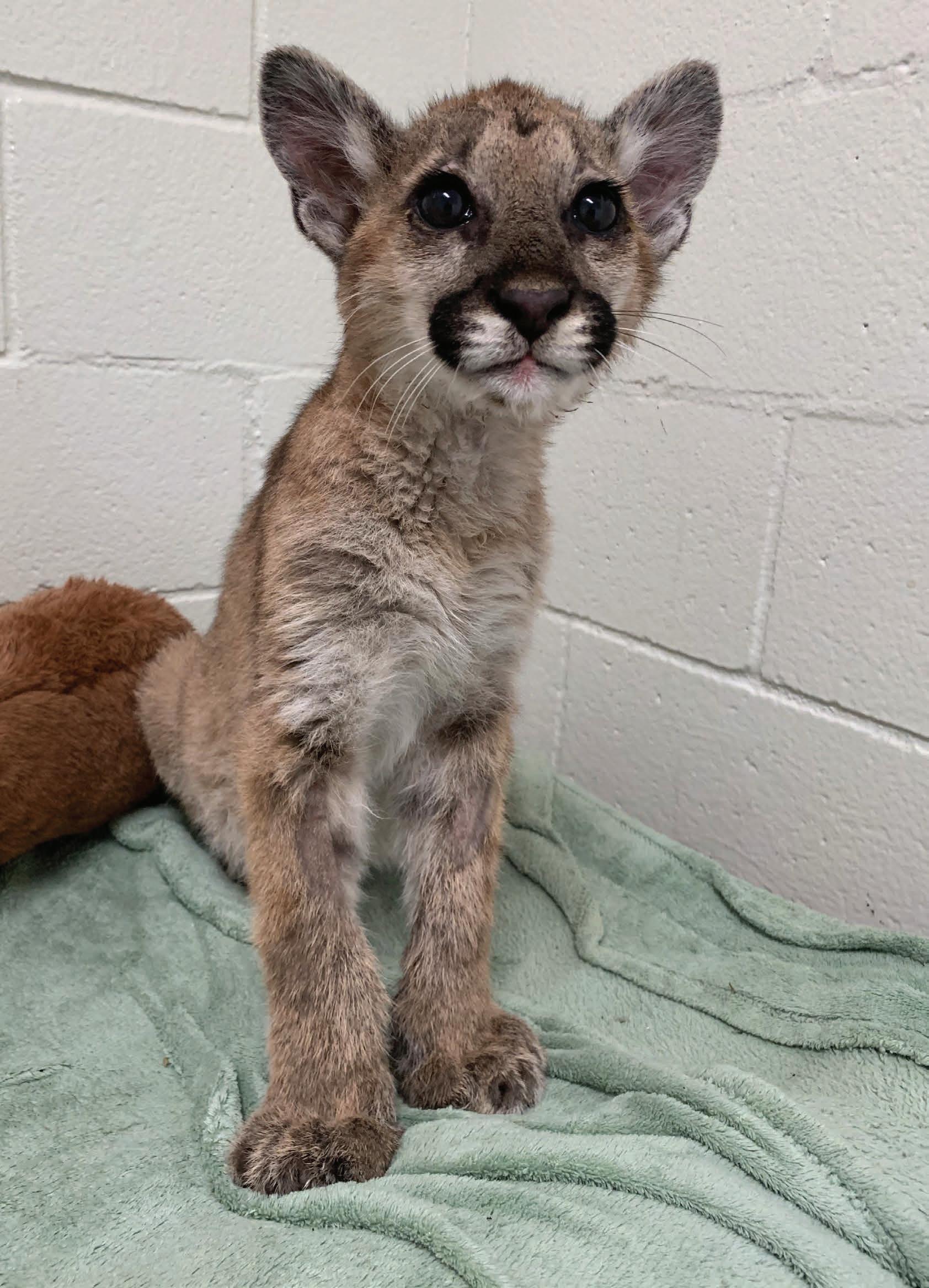
4 minute read
San Diego Humane Society’s Project Wildlife Gives Wild Animals a Second Chance
By Beth Fhaner

PHOTO COURTESY SAN DIEGO HUMANE SOCIETY
Advertisement
When firefighters from the Vista Grande Fire Station spotted an orphaned mountain lion cub near a road in Idyllwild on September 2, she was semiconscious, extremely emaciated, dehydrated and weak. The firefighters needed to quickly find help for this little cub who was in critical condition, so they contacted the California Department of Fish and Wildlife, who then reached out to the only folks who have the expertise to help in cases like these: Project Wildlife.
A program of San Diego Humane Society since 1972, Project Wildlife is the primary resource in San Diego County for wildlife to receive rehabilitative care. Recognized as one of the largest wildlife rehabilitation organizations in the country, Project Wildlife has two campuses: The Pilar & Chuck Bahde Wildlife Center in San Diego, which specializes in smaller prey species, and Project Wildlife-Ramona Campus, which specializes in the larger, predatory species that are typically more common in rural and suburban areas.
On September 1, San Diego Humane Society acquired the Fund for Animals Wildlife Center in Ramona from the Humane Society of the United States. The mountain lion cub was the first wildlife patient to be admitted to the 13-acre Ramona Wildlife Center since San Diego Humane Society’s Project Wildlife took over the facility.

PHOTO COURTESY SAN DIEGO HUMANE SOCIETY

PHOTO COURTESY SAN DIEGO HUMANE SOCIETY

PHOTO COURTESY SAN DIEGO HUMANE SOCIETY
When the cub arrived, the Project Wildlife Team immediately sprang into action, providing lifesaving treatment for the 10.5-pound cub, estimated to be only 14 weeks old. After receiving daily fluid therapy and medications, the cub progressed from five to three small, nutritious meals per day, including ground proteins with milk replacer, which allows her body to make a slow transition to solid foods. Thankfully, the cub is feeling much better now and has more than doubled in weight to 22 pounds!

PHOTO COURTESY SAN DIEGO HUMANE SOCIETY
“With each passing day, she became more active and responsive and, though she still had some medical issues to overcome from being in such a fragile state, we were delighted she responded well to our treatment and were hopeful she’d make a full recovery,” said Christine Barton, director of Operations & Wildlife Rehabilitation at San Diego Humane Society’s Ramona Wildlife Center.

PHOTO COURTESY SAN DIEGO HUMANE SOCIETY
Since mountain lions typically stay with their mother until they leave to live a solitary life around 12 to 18 months of age, it’s not considered safe to return a young mountain lion to the wild if it’s found injured or orphaned as a kitten. For that reason, Project Wildlife worked with the California Department of Fish and Wildlife to monitor the cub’s progress and to ensure that she’d have a good permanent home at a qualified facility. On October 16th, when the cub had been sufficiently stabilized, she was transferred to the Southwest Wildlife Conservation Center in Scottsdale, Arizona, according to San Diego Humane Society spokeswoman Nina Thompson.
As the human population continues to expand, there’s less natural space for wildlife, which greatly increases the need for rehabilitative care and conservation. Every year, Project Wildlife provides more than 12,000 wild animals, including mountain lions, black bears, coyotes, bobcats, skunks, opposums, squirrels and raptors, the best opportunity to receive the nurturing care they need to survive, whether it’s specialized veterinary care, injury rehabilitation or simply a safe place to mature.

PHOTO COURTESY SAN DIEGO HUMANE SOCIETY
A bobcat kitten who had been orphaned, emaciated and was ill with mange, was another wildlife patient recently taken in by the Ramona Wildlife Center. The bobcat kitten had started hanging out at a pool for access to water. Eventually, a concerned citizen was able to trap him and bring him to the Wildlife Center, where he was treated for his mange and subsequent skin infection, while the staff worked on his emaciated physical condition with a nutritious diet.
“Once he recovered and was cleared of any medical concerns, we were able to combine him with our other orphaned bobcat kittens in an outdoor enclosure with a pond and tree, where he continued to grow stronger and learn hunting skills before being released back into his native habitat just this fall,” explains Barton.
Lauren DuBois, Director of Wildlife Rehabilitation at The Pilar & Chuck Bahde Wildlife Center notes that they recently had an interesting case involving a barn owl with a deformed beak. “After Dr. Jon Enyart, DVM, performed orthopedic surgery to correct the beak, the bird responded and healed,” says DuBois. “We are so happy to report the bird has been released!”

PHOTO COURTESY SAN DIEGO HUMANE SOCIETY

PHOTO COURTESY SAN DIEGO HUMANE SOCIETY
“With San Diego being a rich and biodiverse area with wildlife and various ecosystems, there are increased probabilities of encountering wildlife,” adds DuBois. “We hope to educate that we can co-exist with the animals in our neighborhood and teach the public when it is needed to intervene to help the animals.”
By giving injured, orphaned and sick wild animals a second chance at life, Project Wildlife provides a valuable and much-needed service, resulting in many happy animal rescue stories, indeed.
If you encounter injured wildlife in San Diego: If you see injured wildlife, call Project Wildlife at (619) 299-7012 and ask the staff to assess the situation to determine if assistance is needed and the safest method to proceed. More information can be found on their website at sdhumane. org/wildlife.

PHOTO COURTESY SAN DIEGO HUMANE SOCIETY










